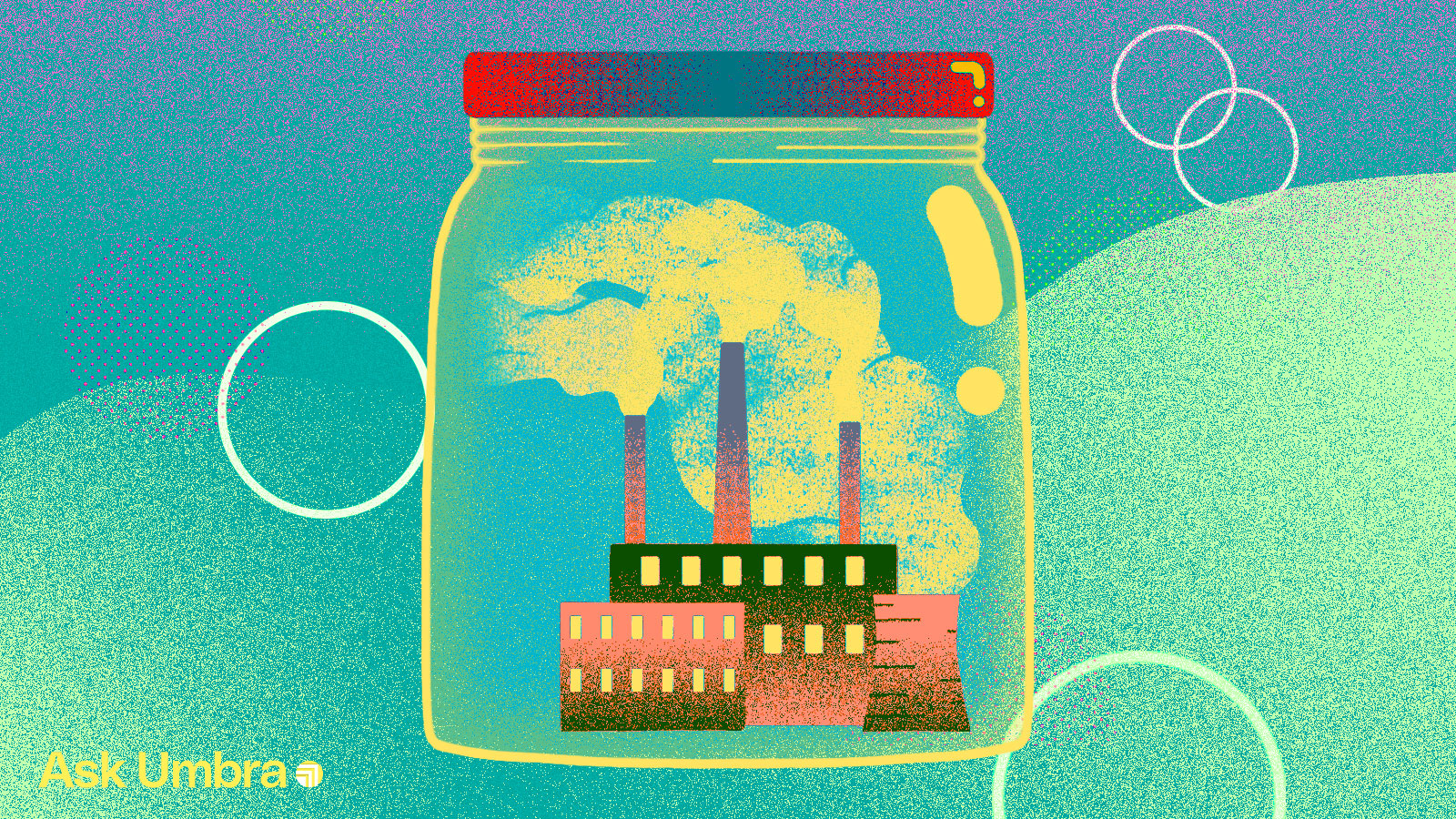Dear Umbra,
Most people get that we have to stop emitting so much CO2. But even if we stopped today, what happens with the CO2 already in the atmosphere? Don’t we have to both stop producing emissions AND take CO2 out of the atmosphere at the same time?
— These Onerous Obstacles Make Undoing Carbonization Hard
Dear TOO MUCH,
I can almost hear the weariness in your voice, and it resonates. We talk so much about the supreme challenge of reducing emissions — something that already requires transitioning our entire economy away from the burning of fossil fuels, adapting to existing climate threats, and doing all that in a way that at the very least doesn’t add to the burdens of already marginalized communities. It’s hard to imagine that there’s more still to do. Can it really be that, on top of all those tasks, we have to pull carbon out of the atmosphere too?
Well, yes.
It’s not like we can just flip a switch in order to return to preindustrial CO2 levels. Zachary Byrum, a research analyst in carbon removal at the World Resources Institute, likes to compare our atmosphere to a rapidly filling bathtub. “Even if we turn the tap off, we still have a bathtub of CO2 that is full up to the top,” he said. “It might evaporate, but that would take a very long time. You have to make a drain so that the water, or CO2 in this metaphor, can go somewhere, and carbon removal is the means to do that.”
There are many types of carbon removal, but they all involve taking existing carbon out of atmospheric circulation, say, by planting new trees, improving soil quality, or using technology to suck it directly out of the air and inject it into the ground. “There is no world in which we don’t need carbon removal” to avert climate disaster, Byrum said.
That urgency is because our atmospheric bathtub is already really close to “overflowing.” According to the latest reading from the National Oceanic and Atmospheric Administration, our current level of atmospheric carbon is around 419 parts per million, or ppm, and continues to rise. Way back before the Industrial Revolution — when we figured out that we could haul fossil fuels out of the ground, burn them, and use the resulting energy to power machinery on a massive scale — that CO2 figure was more like 280 ppm. It has been increasing at an alarming rate ever since. The International Panel on Climate Change estimates that 430 ppm marks the threshold beyond which the climate will heat up by more than 1.5 degrees Celsius above pre-industrial levels — the limit set during the 2015 Paris Agreement.
But some experts say even 430 ppm is too high of a CO2 threshold for many of Earth’s systems to function well. Climate scientist James Hansen has posited that 350 ppm (a benchmark we passed in 1986) is a more reasonable level for planetary health. Some climate scholars argue we have a moral obligation to return to preindustrial levels (280 ppm) if we want to ensure a truly healthy planet for future generations.
Looking at the climate crisis in terms of hard numbers is deeply disconcerting, to say the least, but bear with me if you can. We are still not in a position to “turn off” the CO2 tap. As a globe, we are pumping somewhere between 40 and 50 billion metric tons of carbon dioxide into the atmosphere per year. That number has grown year over year with the exception of 2020, when global COVID-19 restrictions caused emissions to drop an estimated 8 percent. I don’t think I have to tell you that an 8 percent reduction is not very much, or that a global pandemic is not a great way to solve the climate crisis.
Even if all humans immediately wanted to do everything they could to avert climate disaster, it would still take time to shut down all carbon emissions. There are still billions of people throughout the world who rely on fossil fuel-powered infrastructure and greenhouse gas-emitting agricultural methods to live. The decarbonizing shift is underway, but nowhere near complete.
Which brings us back to carbon removal. Importantly, it’s not quite the same thing as carbon capture, which usually happens right at a polluting point source. If you had a natural gas-powered electric plant, for example, you could put some sort of carbon trapping mechanism right on the plant itself to collect the emissions before they are released into the atmosphere.
Some environmental activists have criticized this form of carbon trapping as being bad for communities located near these plants. They also claim it is a kind of Band-Aid technology that keeps fossil fuel infrastructure up and operating versus phasing it out completely and replacing it with cleaner forms of energy, like wind and solar. In contrast, carbon removal refers to a natural or engineered process in which greenhouse gases are removed from the air itself, storing it in some hopefully durable form of carbon sink.
There are many natural carbon sinks such as forests and the ocean, which uptake about half of the CO2 we pour into the atmosphere. Trees are very good at storing carbon, and there has been a lot of noise over recent years that going all Johnny Appleseed on the planet and planting billions of trees is the golden ticket that will save us all, no larger adjustment required. However, that noise has been generally debunked. For one thing, the fact that a lot of trees are burning down to ashes every year in huge wildfires — made worse, in part, by climate-driven heat waves like the one that recently ravaged the Pacific Northwest — means that all the carbon they’ve been storing over decades or even centuries just gets spewed right back out into the air. Yikes!
That risk is one reason some scientists say we need to look for innovative ways to store carbon for the long term once it’s removed from the atmosphere. “We cannot put this stuff back on the Earth’s surface,” said Julio Friedmann, senior research scholar at the Center on Global Energy Policy at Columbia University. “We have to put it back into the ground. Trees can’t hold it — there’s not enough land or biomass, and even if we went back to some Jeffersonian agro-utopia, we still don’t have the storage capacity on the Earth’s surface. If we pull 2 trillion tons of carbon dioxide out of the ground, we have to put 2 trillion back into it.”
One option is injecting the purified carbon taken from carbon removal or carbon capture processes deep into the Earth where it can’t escape. There’s even a way to use chemical processes to store it in rock formations. And as insane as that may seem, researchers say injecting carbon underground is a rather promising strategy. Scientists estimate that our capacity for carbon storage well exceeds what humans have released into the atmosphere throughout all of human history.
There is an argument in some environmentalist circles that investing in carbon removal technology would hamper the will or the urgency to decarbonize our energy and infrastructure and everything else — the “moral hazard” argument. But the link between this argument is much less with carbon removal than, say, carbon capture or carbon offsets, which are directly used to excuse “bad” climate behaviors.
Carbon removal isn’t a hall pass to get us out of our other carbon-reducing obligations. The Intergovernmental Panel on Climate Change itself has said that a pathway to 1.5 degrees of warming would “strik[e] different balances between lowering energy and resource intensity, rate of decarbonization, and the reliance on carbon dioxide removal.” Many forms of carbon removal technology are still quite nascent and operating on a comparatively small scale. Questions remain on how it would work on the level necessary to deal with, say, billions of tons of CO2 per year.
“The reality is, we’re out of time,” said Jennifer Wilcox, of the Office of Fossil Energy and Carbon Management with the Department of Energy, adding that, at this point, any and all climate solutions need to be on the table. “We can’t afford to put all our eggs in one basket — we can’t afford not to do some of these things that 10 years ago didn’t seem like a responsible way forward. We’re in a position where we need all the tools in the kit, but we need to use them in a really responsible way.”
Which brings us back to the climate-concerned, like you and me, TOO MUCH. So how do we process all this, emotionally — knowing that not only do we have to decarbonize our economic system, reform our political structure, and, oh, rethink the entire built environment, but we also have to pull a whole bunch of carbon out of the air?
It’s a tall order, but Friedmann of Columbia’s Center on Global Energy Policy suggests focusing on the world as it could be. “The most valuable thing to contribute is a positive vision, which is one in which we have abundant clean energy, we choose to value the natural world in a real way and restore it, and we have invented the tools and capabilities we have to make that real, and we do it in a way to make that equitable,” he said. “And all of that is in bounds and totally within our control.”
So deep breaths, TOO MUCH. As I have said before: What’s done has to be undone, there’s no real way around it, so we might as well roll up your sleeves — in whatever metaphorical way suits you best.
Anxiously,
Umbra



